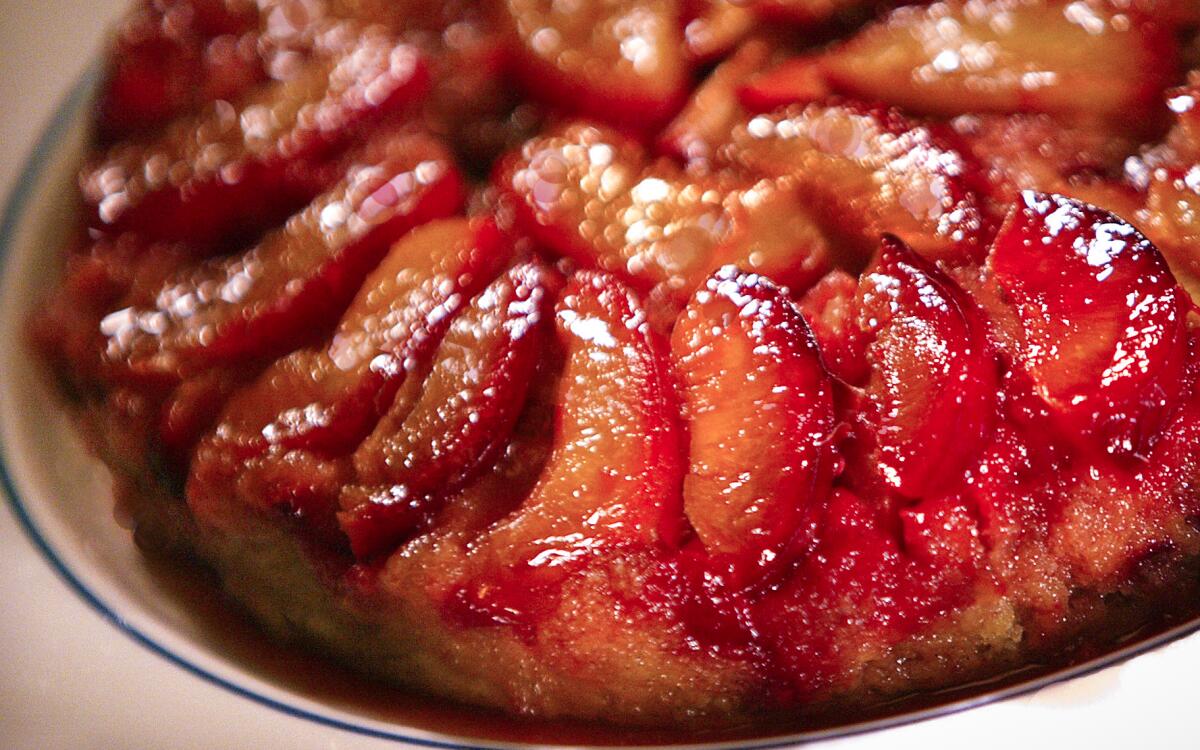Plum upside-down cake

- Share via
It’s late afternoon at the farmers market. Shoppers have had a few hours already to load up on white and yellow peaches and nectarines, apricots and three kinds of plums, but still there’s a crowd around a counter where wedges of fruit are available to taste.
Little kids with chins already sticky with juice push forward for one more sample; meticulous matrons smack their lips over fragrant white nectarines. Buyers wave bills and go back and fill their bags with another half-dozen plums or peaches.
Relax. Take a deep breath. Time is not running out on the stone fruit season.
This year, thanks to weirdly favorable weather conditions, California’s crops of peaches, nectarines and plums have been early (10 days to two weeks in most cases) and abundant. Marty Willbanks of the Olson Family Farm in Kingsburg just south of Fresno says that the stone fruit crop is “outstanding and better than normal” this year and that the fruit is sweeter than usual because of early hot weather.
Add that bounty to the availability of new varieties that ripen in late summer and early fall and we’re barely into one of the best seasons in memory.
Think of it -- you have until early October to indulge, one way or another. Peach pie? Why not? Cobblers and crisps? Of course. Preserves, chutneys, sauces? This is the year to bake and can.
There are dozens of varieties of peaches, nectarines and plums. Through June, look for Fancy Lady peaches, Flavor Crest peaches, Blenheim apricots and Santa Rosa plums. In late June, Elegant Lady peaches and Blackamber plums come into the markets. Early July brings Fantasia nectarines and Friar plums, while Elephant Heart plums can be found in late July. The old-fashioned favorite O’Henry peaches are available beginning in August.
When buying peaches and nectarines, look for those with a yellow background color (although that ranges from a pale creamy color to a bright gold, depending on the variety), with no traces of green (a sign that the fruit was picked too early and will not ripen). Many stone fruit farmers are happy to help you choose fruit depending on when you’d like to eat or cook it.
Use ripe fruit to make poached peaches in mint syrup -- the skins slip off easily with the help of a small paring knife. It takes just five minutes for the peaches to poach, but a cooling surprise comes in the juxtaposition of mint and sweet fruit.
It’s hard for us not to eat all the Santa Rosa plums we get our hands on, but we’ve exercised the utmost restraint and used them in a modern upside-down cake. Nectarines or peaches work just as well, and with any of these, the fruit yields a juicy glaze that soaks into the cake when it’s inverted after cooking. The cake itself, a simple batter enriched with browned butter and vanilla bean, is a little softer and sweeter than a shortcake.
Our apricot tart takes advantage of the fact that thin-skinned apricots need no peeling, so it’s easy to cut picture-perfect halves. Use perfectly ripe apricots for this recipe, not too soft and not too hard. Apricots and almonds are an irresistible combination, and the ground-almond crust of this tart is sophisticated in flavor and forgiving in preparation. The filling of apricot halves in a rich custard is finished a la a creme brulee.
Heat the oven to 350 degrees.
Cut one-fourth cup butter into pieces and add it to a small saucepan or skillet. Heat over medium heat until the butter browns but does not burn. Pour the browned butter into a small bowl and refrigerate until the butter solidifies.
With the tip of a knife, scrape the seeds from the vanilla bean halves into the milk and then add the pods. Heat the milk until it’s warm. Remove it from the heat and set aside to steep and cool.
Melt the remaining butter in a small, nonstick skillet. Remove it from the heat and add the brown sugar, stirring until the sugar dissolves. Pour the mixture into an 8-by-2-inch buttered cake pan, evenly coating the bottom of the pan.
Cut the plums in half, then cut each half into 3 or 4 slices. Arrange the slices in a single layer of concentric circles, beginning at the outside edge of the pan, so they are touching but not overlapping. Cover the bottom of the pan, then arrange a second layer of fruit on top. Set aside while preparing the cake batter.
Beat the cooled browned butter until light and fluffy. Beat in the sugar until creamy. Beat in the egg until blended.
In another bowl, stir together the cake flour, salt and baking powder. Remove the vanilla bean from the milk.
Fold the flour mixture into the butter-sugar mixture alternately with the vanilla-bean milk. Begin and end with the flour mixture.
Gently spoon the batter over the top of the sliced plums in the cake pan. Spread the batter over the fruit so all the fruit is covered and the batter is distributed to the sides of the pan.
Bake until the cake tests done in the center and is golden brown, about 50 to 55 minutes.
Remove the cake from the oven and let it stand for a few minutes. Run a knife around the sides of the cake to loosen the edges. Put a serving plate on top of the cake and invert. Carefully remove the baking pan from the cake. Cool. Serve warm.
Get our Cooking newsletter.
Your roundup of inspiring recipes and kitchen tricks.
You may occasionally receive promotional content from the Los Angeles Times.















